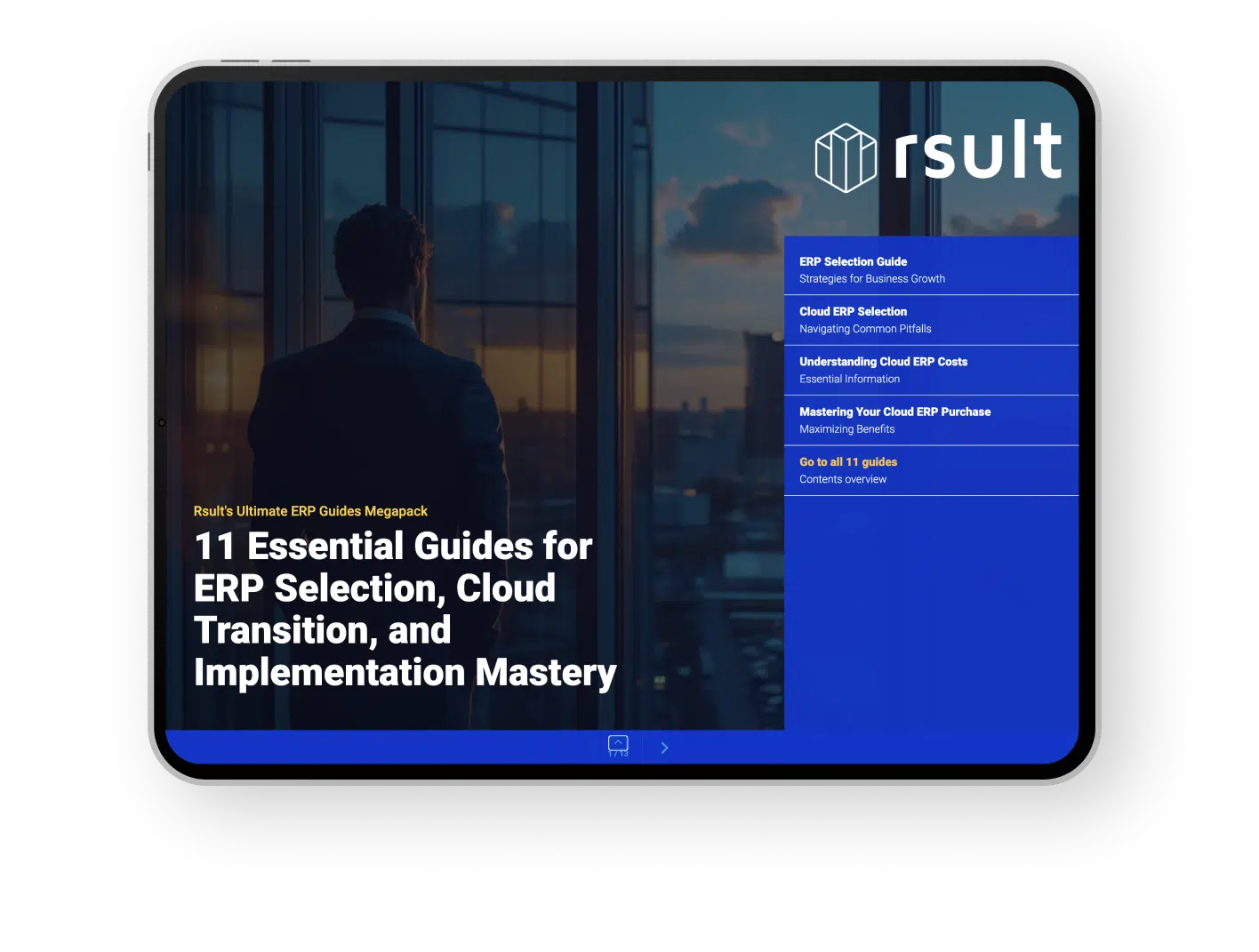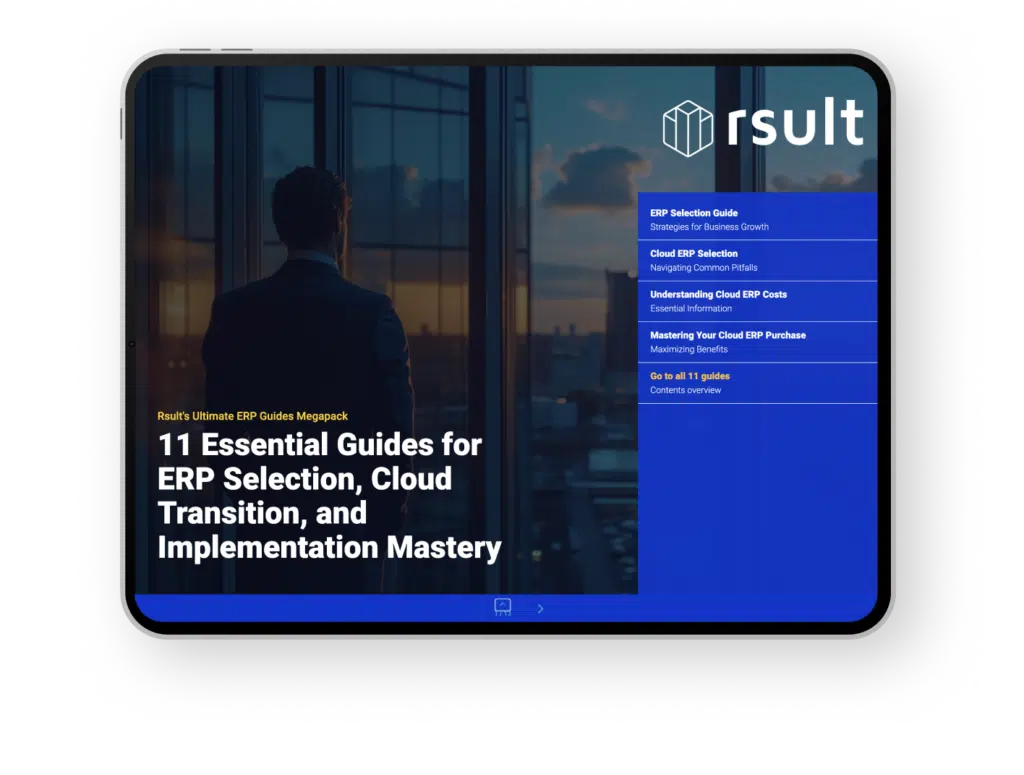As someone at the helm of an apparel enterprise, you know that precision and adaptability are not just desirable—they’re essential for thriving in the dynamic world of fashion. An ERP for the Apparel Industry isn’t just a piece of software; it’s the linchpin of efficiency and growth, offering tailored features and industry-specific benefits that are as multifaceted and detailed as the designs your business creates. Let’s explore how apparel ERP software can transform your fashion manufacturing operation into a sleek, streamlined powerhouse that not only meets but exceeds the demands of this fast-paced industry.
Key Takeaways
- Unlock the potential of fashion manufacturing software with tools designed specifically for your industry.
- Discover the high value in implementing an ERP solution that boasts industry-specific benefits tailored to your business needs.
- Learn about the comprehensive modules and functionalities that drive efficiency in the apparel ERP software.
- See how the right ERP can improve your control over the apparel supply chain, from sourcing to sales.
- Find out how an ERP system can lead to improved profitability through better visibility and control of your business processes.
- Explore ERP solutions that are tailored to tackle the diverse challenges unique to the fashion and apparel sector.
Understanding ERP for Apparel Industry
As a professional in the fashion sector, you’re well aware that the dynamics of apparel manufacturing are complex and ever-changing. Meeting these challenges requires more than just any software; you need an industry-specific ERP software tailored to keep pace with fashion’s rapid cycles and detailed production processes.
Defining Industry-Specific ERP Software
Industry-specific ERP software is crafted to cater specifically to the nuanced needs of apparel producers. Unlike generic ERPs, a fashion manufacturing software contains specialized tools and functionalities that streamline every step of the apparel manufacturing process.
The Importance of Tailored Solutions in Apparel Manufacturing
When it comes to apparel production, one size does not fit all. The necessity for customized features for apparel production is undeniable. With a bespoke textile industry ERP system, you’re equipped with a powerful suite of tools designed to manage the unique aspects of fashion manufacturing from the ground up.
| ERP Feature | Benefit for Apparel Industry |
|---|---|
| Materials Requirements Planning (MRP) | Optimizes inventory levels, reduces waste, and plans purchasing of raw materials |
| Demand Planning and Forecasting | Ensures production aligns with market demands and minimizes overproduction |
| Inventory Management | Tracks fabric, trim, and final products efficiently across various SKUs |
| Warehouse Management | Enhances storage optimization and streamlines fulfillment processes |
By leveraging an ERP with these targeted features, your apparel firm can achieve excellent coordination among departments, which is central to nurturing a profitable and sustainable business.
Integrating Design and Development in Fashion Manufacturing Software
The core of your business efficiency in the apparel industry starts with the integration of design and development. It’s the heartbeat that ensures your apparel manufacturing process stays at the forefront of innovation. By utilizing ERP solutions specifically crafted for the apparel industry, you can synchronize garment production management with cutting-edge design, ensuring a seamless, streamlined workflow from concept to final product—integrating design and development is no longer just a possibility; it’s essential.
- Real-time Data Use: You can track design changes as they happen, ensuring that your production team always has the latest information at their fingertips.
- Materials Management: The software helps in precisely recording fabric specifications and inventory, which play a crucial role in maintaining the quality and consistency of your garments.
- Collaboration Tools: Enhancing cooperation among designers, production teams, and suppliers is made simpler with communication features, turning collaborative efforts into a competitive edge.
- Streamlined Prototyping: Speed up prototyping and sampling to quickly adapt to market demands without compromising the designed quality.
By having an ERP for Apparel Industry with integrated design and development, not only are you supporting a cohesive and efficient apparel manufacturing process, you’re also laying the foundation for products that meet the quick pace and quality demands of modern fashion markets. Embrace the technological innovations that mirror the dynamism of your creative processes and ensure the integrity of your designs as they come to life.
Textile Industry ERP System: Material and Inventory Synchronization
When you’re in the business of apparel, managing materials and inventory can become as complex as the fashion designs you produce. Understanding this, a textile industry ERP system comes equipped with savvy features for material requirements planning (MRP) and inventory management, designed to keep you ahead in the fast-paced world of fashion. These systems ensure that your material usage is optimized and inventory is balanced, making you more efficient, reducing costs, and minimizing wasted resources.
Material Requirements Planning (MRP) in Apparel
Every thread counts in the apparel industry, and that’s where apparel industry MRP comes into play. You need to know exactly what materials are required, in what quantities, and by when to keep production running smoothly. A focused ERP system provides you with detailed insights into your fabric stock and usage patterns. This intel comes in handy for making informed purchasing decisions, meaning less overstocking, better budgeting, and a decrease in storage costs.
Inventory Management Specific to Clothing Products
Inventory management in clothing production is unique due to the variety of sizes, colors, and styles that must be tracked. Clothing production software simplifies this task by efficiently storing and managing information about each variant. It keeps your supply chain agile, adjusting your inventory levels to meet market demands without skipping a beat – or skipping a size. With better synchronization between material requirements and market trends, you can experience a smoother operational flow and improved customer satisfaction.
| Inventory Feature | Benefits |
|---|---|
| Size and Color Tracking | Keeps variations organized reducing the risk of stockouts for popular items |
| Real-time Stock Levels | Enables quick response to demand changes and minimizes excess inventory |
| Automated Reordering | Helps maintain optimal inventory levels by prompting reorders at the right time |
| Supplier Management | Centralizes supplier data and performance, simplifying restock processes |
| Seasonal Forecasting | Allows planning for seasonal variations in demand to prevent overproduction |
Addressing Supply Chain Complexities with Apparel Supply Chain Management
As you explore solutions for apparel supply chain management, understanding the capabilities of an ERP for Apparel Industry is essential. The right system streamlines your operations, providing supply chain optimization that brings clarity and efficiency to your business. With features designed for the apparel industry, such as real-time tracking and sustainable workflows, these systems enable you to keep pace with the dynamic fashion environment.
Consider how an ERP can transform your supply chain:
- Visibility across the entire supply chain, from material sourcing to product distribution
- Proactive disruption management to maintain continuous operation
- Efficient management of global distribution channels
The benefits are clear:
- Enhanced sustainability in operations through improved resource allocation
- Strategic advantages with real-time tracking for inventory and shipments
- Stay competitive by rapidly adapting to market changes and opportunities
| Feature | Benefits | Outcome |
|---|---|---|
| Raw Material Sourcing Visibility | Reduces over-ordering and waste | Cost-efficient and eco-friendly operations |
| Real-Time Distribution Tracking | Enables quick response to demand shifts | Minimized stockouts and overstocking |
| Global Distribution Channel Management | Consolidates shipments and reduces delays | Faster product delivery to marketplaces |
| Disruption Management Tools | Preparation for unforeseen supply chain disruptions | Continuity of operations during crises |
Investing in an ERP that specializes in apparel supply chain management is not just an upgrade to your current system; it’s a strategic move to power your business through technology that understands the intricacies of the apparel industry. With increased efficiency and a clear oversight of your supply chain, you’ll be well-positioned to navigate the complexities of today’s fashion market.
Customization and Compliance in Apparel ERP Software
In the fast-paced world of fashion, your ability to stay flexible and compliant can make all the difference. This is where customizable ERP systems become invaluable. With ERP software tailored for the fashion enterprise resource planning niche, you have the power to adjust the features and workflows to match the unique needs of your business. As your company evolves, so too can your ERP system, thanks to its scalable ERP solutions. Whether you’re expanding your product line or entering new markets, your ERP system should grow with your ambitions.
Modular Nature and Scalability of ERP Systems
Every fashion enterprise has its own set of processes and challenges, and a one-size-fits-all solution is rarely effective. Modular ERP platforms allow you to select and customize modules specific to your operational needs. From production to distribution, you can scale each module alongside your business’s growth without overhauling your entire system. This scalable approach means you can start with what you need and add on as required, ensuring that your investment is optimized at every stage of your business expansion.
Regulatory Compliance and Quality Control Measures
Navigating the complexities of regulatory compliance in the apparel industry can be daunting. Your ERP system plays a vital role in ensuring that your business not only meets but exceeds the statutory requirements for your products. Furthermore, with intensive quality control in apparel, an advanced ERP solution helps maintain the excellence and integrity of your brand by systematically managing quality checkpoints. So whether it’s adhering to international trade regulations or meeting product safety standards, a robust ERP system can help you maintain compliance with ease and precision.
Garment Production Management: Streamlining Operations
As you plunge into the depths of garment production management, you’ll find that ERP for Apparel Industry is not just a tool but a transformative ally. Imagine all production-related departments communicating harmoniously, from CAD to quality assurance, leading to streamlined manufacturing processes. By leveraging ERP systems, silos are dismantled, creating a cohesive environment for enhanced productivity.
Let’s look at how this could play out in your daily operations:
- Improved Production Planning: Scheduling complex garment production activities becomes a walk in the park, thanks to advanced ERP capabilities that allow for meticulous planning and resource allocation.
- Centralized Information: With a centralized database, you have immediate access to critical information, from design specifics to production timelines, all at your fingertips.
- Enhanced Coordination: Departments that operate in their own bubbles can now synchronize efforts, leading to an acceleration in your production cycle and a notable increase in efficiency.
- Quality Assurance: Keep your production in check with integrated quality control protocols, ensuring each piece meets your high standards before it leaves the factory floor.
At the heart of it, an ERP system tailored for the apparel industry is akin to the conductor of an orchestra—each section plays its part, coming together to create a symphony of streamlined operations. Your role in managing these operations pivots from being reactive to proactive, allowing you to meet delivery deadlines with ease and promise better product quality. In the world of fashion, where time is as valuable as the garments you produce, this kind of efficiency is invaluable.
Ultimately, the power of garment production management through an ERP empowers you to craft an operation that not only delivers on its promises but also exceeds the expectations of your market, consistently. Opt for an ERP system that complements the rhythm of your apparel manufacturing, and you’ll be setting the stage for success in an incredibly competitive industry.
Cost Reduction and ROI of Textile Manufacturing Software
Embracing textile manufacturing software is not merely about keeping pace with industry advancements—it’s about achieving tangible cost reduction and a substantial return on investment (ROI). By automating ERP processes, apparel businesses can minimize expenses not only through the elimination of manual errors but also by streamlining their operations, leading to increased profitability and competitive advantage.
Reducing Overhead with Automated Processes
As you dive deeper into the integration of automated ERP processes, you’ll discover a myriad of avenues for cost reduction. Inventory inaccuracies can lead to either excess stock or stockouts, both of which are costly scenarios. With advanced apparel ERP software, your inventory management becomes a finely-tuned engine that syncs up with demand, maximizing turnover rates and minimizing carrying costs.
Calculating ERP’s Return on Investment for Apparel Industries
Transparently assessing the return on investment for adopting an ERP system in the apparel industry could be your guiding light in decision-making. To aid in this, consider the following comparative analysis that demonstrates the benefits of implementing ERP software and the potential returns that can be reaped within various operational divisions.
| Operation | Before ERP Implementation | After ERP Implementation | Impact |
|---|---|---|---|
| Inventory Management | Manual tracking; data prone to errors | Automated real-time tracking; high accuracy | Reduction in excess stock and stockouts |
| Order Processing | Time-consuming, error-prone entry | Streamlined digital processing | Increased order accuracy and customer satisfaction |
| Production Scheduling | Reactive, often leads to bottlenecks | Proactive, demand-driven | Improved workflow, reduced idle machine time |
| Cost Monitoring | Ad-hoc and inconsistent | Consistent, with detailed analytics | Better decision making, highlighting cost-saving areas |
By delving into these ERP-driven improvements, you can see that the cost-saving potential is substantial. The upfront investment in apparel ERP software might seem daunting at first, but the long-term financial benefits, paired with strategic growth opportunities, can transform your business trajectory. Remember, it’s not just about saving money—it’s about investing in your company’s future.
Agility and Forecasting: Adapting to Fashion Industry Trends
In the fast-paced world of fashion, your ability to pivot on a dime is not just an advantage—it’s a necessity. With fashion industry trends evolving at a breakneck speed, the implementation of agile ERP solutions can be the key to maintaining your competitive edge. These robust systems offer sophisticated forecasting demand in apparel capabilities built to process vast amounts of data—this includes parsing through historical sales figures, analyzing consumer behavior, and keeping a keen eye on the overall market dynamics.
By doing so, your business can anticipate shifts in consumer preferences and transform these insights into actionable strategies. Whether it’s scaling up production to meet an unexpected surge in demand or pulling back on manufacturing to prevent overstock, an adaptive textile industry ERP system positions you to manage your inventory with precision. The goal here is to help you avoid the pitfalls of surplus or deficient stock levels while ensuring your product offerings resonate with the now.
Embrace these ERP tools to fine-tune your operations such that they resonate with the rhythm of today’s fashion beat. Your brand’s agility in responding to emerging trends is bolstered by accurate forecasting, setting you apart as a leader rather than a follower in the fashion domain. With your finger firmly placed on the pulse of the current market, you can look forward to a future where your product lines are not only in demand but also dynamically aligned with the evolving desires of your clientele.
FAQ
What specific benefits does ERP for the Apparel Industry provide?
ERP for the Apparel Industry offers customized modules for fashion manufacturing, enhanced resource planning, inventory management, and improved apparel supply chain management. These features ensure that every step of the apparel manufacturing process, from design to distribution, is optimized for efficiency and profitability.
How does industry-specific ERP software support the apparel manufacturing process?
Tailored ERP solutions support the apparel manufacturing process by offering specialized functionalities such as forecasting, materials requirements planning (MRP), inventory management, and overall integration of various departments. This leads to better management of complex production details and faster fashion cycles.
How do fashion manufacturing software solutions integrate design and development?
Apparel ERP software facilitates the integration of design and development by maintaining detailed databases that capture fabric specifics, design changes, and development stages. This seamless integration fast-tracks product time to market, bridging the gap between design, sampling, and production.
What role does Material Requirements Planning (MRP) play in the apparel industry?
MRP is crucial for managing color, size, and style inventory, allowing companies to optimize fabric and trim use, reduce waste, and lower costs. It provides insights into inventory needs, helping businesses make informed purchasing decisions and maintain efficiency.
How does inventory management in clothing ERP systems differ from other industries?
Clothing ERP systems offer inventory management that accommodates the diverse ranges of sizes, colors, and styles characteristic of the apparel industry. It ensures efficient tracking of numerous variants and helps align inventory with market demands and sales cycles.
In what ways can ERP software streamline apparel supply chain management?
ERP software provides visibility and real-time tracking across the supply chain, from raw materials to finished goods. It allows businesses to react quickly to disruptions, manage distribution channels globally, and promote sustainable practices throughout their operations.
Why is customization important in selecting an ERP system for the fashion industry?
Customization ensures that the ERP system can adapt to the unique workflows and processes of each apparel business. Modular and scalable ERP solutions allow for expansion and refinement as the business grows and changes, supporting individual needs and innovation.
How do ERP systems in the apparel industry address regulatory compliance and quality control?
ERP systems provide modules for tracking compliance with industry regulations and managing quality control measures. This helps ensure that products meet the highest standards and that companies comply with ethical and sustainable manufacturing practices.
What are the advantages of using an ERP system for garment production management?
An ERP system centralizes garment production management, allowing for better coordination across departments, more efficient scheduling, and improved production execution. This results in higher product quality, reduced lead times, and a more reliable ability to meet deadlines.
How can implementing ERP software reduce costs in the textile manufacturing industry?
ERP software automates processes and reduces the chances of human error, effectively cutting overhead costs and improving operational efficiency. This cost reduction is significant when calculating the ERP’s return on investment, as it often outweighs the initial outlay for the system.
How do ERP solutions help apparel companies stay agile and respond to fashion industry trends?
ERP solutions offer forecasting tools that utilize data analysis to predict market demands and adjust production swiftly. This agility helps apparel companies avoid inventory issues and align their offerings with consumer desires, keeping them competitive and trend-forward.
What is the ROI of implementing an ERP system in the apparel industry?
The return on investment for an apparel industry ERP system comes from increased efficiency, cost savings from optimized processes, and improved management that leads to better decision-making. While the initial investment might seem substantial, the long-term benefits typically surpass these costs, contributing to business growth and success.






